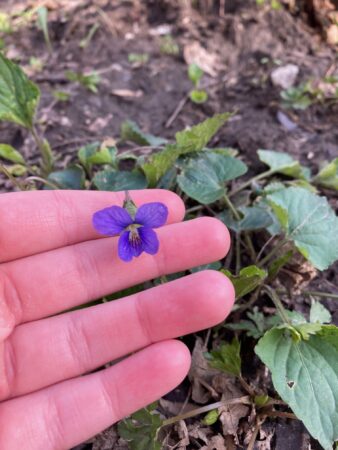


Violets belong to the plant family Violaceae. The genus Viola contains over 500 species. The Viola sororia species is native to North America and one of the most common wild violets – referred to as “wild violet”, “wood violet”, or “common blue violet”. Most violets are some shade of purple but can also come in white, red, pink, coral, and yellow. Violets are found in forests, lawns, and gardens. Violets can be seen blooming all the way from late winter to late summer.
You may also be familiar with the commonly grown flower the pansy. Pansies are all within the Viola genus as well.
Morphology
Since Viola is home to so many different species, their morphology does vary. However, most have heart-shaped or kidney-shaped leaves with leafy stipules. The leaves are either basal (at the base of the plant) or alternately arranged.
The flowers are solitary, meaning one per stalk. Their flowers also have 5 sepals, 5 stamen, and 1 ovary that contains 3 placentae with multiple ovules each. The flowers are famous for their zygomorphic (bilateral) symmetry, meaning that when the flower is split down the middle both sides will look mirrored.

The fruits of violets are carpels with 3 valves where the 3 placentae were, and seeds contained in each valve. Upon drying, these valves will split open and eject the seeds.
Uses and Meaning
Violets symbolize faith, humility, creativity, and grace.
Some violets are edible (both the leaves and the flowers) and the flowers are sometimes used as edible flowers in desserts or salads.
Violets have cleansing and anti-inflammatory properties that have made them useful for topical balms and lotions. They also contain vitamins and make a good nutritional tea.
Violets were used in ancient Greece to make wine.
Another fun fact about violets – they smell nice, but the smell seems to disappear after one sniff making you wonder if you really smelled them at all. This is because violets contain a chemical called ionone which desensitizes the nose and blocks your sense of smell temporarily.
If you enjoyed this plant profile on violets, check out the last plant profile on dandelions.


Comments
2 responses to “Plant Profile: All About Violets”
[…] If you enjoyed this plant profile on irises, check out this plant profile all about violets. […]
[…] you enjoyed this post about lilies, check out some other plant profiles about violets or […]